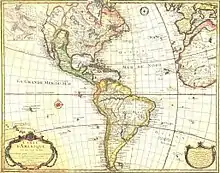Juan Pardo (explorer)
Juan Pardo was a Spanish explorer who was active in the later half of the sixteenth century. He led a Spanish expedition from the Atlantic coast through what is now North and South Carolina and into eastern Tennessee[1] on the orders of Pedro Menéndez de Avilés, in an attempt to find an inland route to a silver-producing town in Mexico.
.jpg.webp)
Menéndez had built Fort San Felipe (1566), and established Santa Elena, on present-day Parris Island;[2] these were the first Spanish settlements in what is now South Carolina.
While leading his expedition deeper into the interior, Pardo founded Fort San Juan at Joara, the first European settlement (1567–1568) in the interior of North Carolina, and five additional forts to the west.[3]
New World exploration
Pardo led two expeditions from Santa Elena into the interior of the present-day southeastern United States. The first, from December 1, 1566 to March 7, 1567, numbered 125 men who went to seek food and to establish bases among the region's indigenous people.[4] He established Fort San Juan at Joara, a Mississippian culture center (near present-day Morganton, North Carolina) and left a garrison behind. Claiming the settlement for Spain, he renamed it Cuenca in honor of his Spanish city Cuenca.[5]
Pardo led a second expedition from September 1, 1567 to March 2, 1568, and explored the Piedmont interior and south along the Appalachian Mountains. He established an additional five forts to the west of Joara, intended to supply a land route to Zacatecas in present-day Mexico, where the Spanish had silver mines they wanted to protect. The Spanish mistakenly thought the Appalachians were connected to a central Mexican mountain range. Pardo returned to Santa Elena when he learned of a French raid there.
Later in 1568, the Native Americans turned against Pardo's garrisons in the interior, killing all but one of the 120 men and burning down all six forts. The Spanish did not make another effort to colonize the interior of North Carolina. The Joara and Fort San Juan sites are being excavated through the Joara Foundation and a partnership with Warren Wilson College.[6]
A stone speculated, but unsubstantiated, to have been inscribed by Pardo or one of his men is in the collection of the Spartanburg Regional Museum of History. Considered a "portable petroglyph", it is inscribed with a parallelogram, a pictograph of the sun pointing away from it, and the date "1567". The stone was found in 1934 by a farmer near Inman, South Carolina.[7]
In 1569, Pardo left the Florida colony to return to Spain; no further details about his life and death are known after that.[8]
Archaeological evidence
Since 1986, archaeologists working at the Berry Site near Morganton have found evidence of mound culture, burned huts and 16th-century Spanish artifacts. There is strong scholarly consensus that this is the site of Joara and Fort San Juan. In 2007, the archaeologists fully excavated one of the burned huts. They found Spanish ceramic olive jar fragments, and iron plate from a 16th-century Brigadine type armor, typical of what the expedition would have used.[9][10]
See also
References
- Chester B. DePratter; Charles M. Hudson; Marvin T. Smith (October 1983). "The Route of Juan Pardo's Explorations in the Interior Southeast, 1566-1568". The Florida Historical Quarterly. Florida Historical Society. 62 (2): 125.
- David J. Weber (1992). The Spanish Frontier in North America. Yale University Press. p. 70. ISBN 978-0-300-05917-5.
- Beck, Robin A., Jr.; Moore, David G.; Rodning, Christopher B. (2006). "Identifying Fort San Juan: A Sixteenth-Century Spanish Occupation at the Berry Site, North Carolina" (PDF). Southeastern Archaeology. 25 (1): 65–77. Retrieved 2013-12-27.
- "Juan Pardo expeditions". North Carolina History. 2016.
- Troy L. Kickler. "Juan Pardo Expeditions". North Carolina History Project. John Locke Foundation. Archived from the original on 8 April 2016. Retrieved 6 December 2020.
- "Today in Asheville history: Explorer arrives". Citizen Times. 1 December 2015.
- Tommy Charles (31 August 2012). Discovering South Carolina's Rock Art. University of South Carolina Press. pp. 19, 120. ISBN 978-1-61117-212-6.
- "Pardo, Juan". South Carolina Encyclopedia. 2016.
- Constance E. Rice, "Contact and Conflict", American Archaeologist, Spring 2008, pp.14 and 17, accessed 26 Jun 2008
- "Fort Tells of Spain's Early Ambitions". New York Times.
Further reading
| Library resources about Juan Pardo (explorer) |
- Hudson, Charles M. (1990). The Juan Pardo expeditions: Explorations of the Carolinas and Tennessee, 1566–1568. Washington, D.C.: Smithsonian Institution Press. ISBN 9780817351908. OCLC 20422515.
- Clark, Larry Richard (2015). The Last Conquistadors of Southeast North America: Pedro Menendez and the Collapse of La Florida's Frontier. Morganton, NC: TimeSpan Press.ISBN 978-1514119020
